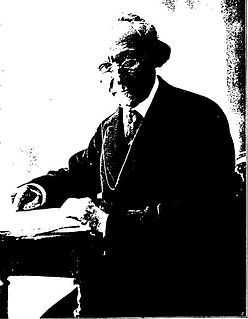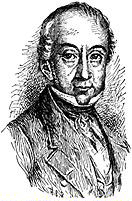Notes
- 1 2 3 4 5 6
 Rosenthal, Herman; Gottlieb, Julius (1901–1906). "Satanow, Isaac Ha-Levi". In Singer, Isidore; et al. (eds.). The Jewish Encyclopedia . New York: Funk & Wagnalls. Retrieved December 13, 2011.
Rosenthal, Herman; Gottlieb, Julius (1901–1906). "Satanow, Isaac Ha-Levi". In Singer, Isidore; et al. (eds.). The Jewish Encyclopedia . New York: Funk & Wagnalls. Retrieved December 13, 2011.
Isaac Satanow (born at Satanow, Poland (currently in Ukraine), 1732; died in Berlin, Germany, 25 December 1804) was a Polish-Jewish maskil , scholar, and poet.
Born to a Jewish family in Satanow, in early manhood he left his native country and went to Berlin in search of learning. There he became the protégé of Daniel Itzig and David Friedländer, who found him employment as a teacher in some prominent families. [1]
Satanow represents a peculiar type. Like Byron, he was, both physically and mentally, a conglomeration of contrasts. He dressed in the garb of the Polish Jew of the period, yet was a thorough German in his actions and habits. Though Orthodox in his beliefs, he nevertheless favored Reform in practise. He was one of the greatest authorities on Jewish tradition and lore, yet he was one of the most free-thinking of philosophers. He was a shrewd physicist and an inspired poet; a realist and an idealist. [1]
In his Mishle Asaf, he so blended the style of the Bible with modern fine writing that the critics of his time were at a loss how to characterize the work. Some were inclined to revere it as a relic of antiquity, while others attacked the author as a literary charlatan who desired to palm off his own work as a production of the ancient writers. Rabbi Joseph ben Meir Teomim gave a clever criticism :
While writing his Mishle Asaf, a work in which noble thoughts are expressed in the choicest diction, he did not disdain at the same time to write a treatise on how to drill holes through three hundred pearls in one day and how to mix successfully different kinds of liquors. Even in the most earnest and solemn of his writings there can always be detected an undercurrent of the most playful humor. [1]
Satanow as a poet belongs to two distinctly different schools. In his earlier works he followed the theory of the old school, which considered plays on words, great flourish of diction, and variegated expressions as the essential requirements of good poetry; but in his later works he used the simple, forceful style of the Biblical writers, and he may be justly styled "the restorer of Biblical poetry." It is sufficient to compare his "Eder ha-Yeḳar" and "Sefer ha-Ḥizzayon" with his "Mishle Asaf" to see at a glance the difference in style. [1]
Among Satanow's most important works are the following:

Abraham ben Meir Ibn Ezra was one of the most distinguished Jewish biblical commentators and philosophers of the Middle Ages. He was born in Tudela, Taifa of Zaragoza and present-day Navarre.

Sa'adiah ben Yosef Gaon was a prominent rabbi, gaon, Jewish philosopher, and exegete who was active in the Abbasid Caliphate.

Judah Halevi was a Spanish Jewish physician, poet and philosopher. He was born in Spain, either in Toledo or Tudela, in 1075 or 1086, and died shortly after arriving in the Holy Land in 1141, at that point the Crusader Kingdom of Jerusalem.
Berechiah ben Natronai Krespia ha-Nakdan was a Jewish exegete, ethical writer, grammarian, translator, poet, and philosopher. His best-known works are Mishlè Shu'alim and Sefer ha-Ḥibbur.

Hai ben Sherira better known as Hai Gaon, was a medieval Jewish theologian, rabbi and scholar who served as Gaon of the Talmudic academy of Pumbedita during the early 11th century. He was born in 939 and died on March 28, 1038. He received his Talmudic education from his father, Sherira ben Hanina, and in early life acted as his assistant in teaching. In his forty-fourth year he became associated with his father as "av bet din," and with him delivered many joint decisions. According to Sefer HaKabbalah of Rabbi Abraham ben David (Ravad), he was the last of the Geonim.
Eleazar of Worms, or Eleazar ben Judah ben Kalonymus, also sometimes known today as Eleazar Rokeach from the title of his Book of the Perfumer —where the numerical value of "Perfumer" is equal to Eleazar, was a leading Talmudist and Kabbalist, and the last major member of the Hasidei Ashkenaz, a group of German Jewish pietists.
Jacob ben Meir, best known as Rabbeinu Tam, was one of the most renowned Ashkenazi Jewish rabbis and leading French Tosafists, a leading halakhic authority in his generation, and a grandson of Rashi. Known as "Rabbeinu", he acquired the Hebrew suffix "Tam" meaning straightforward; it was originally used in the Book of Genesis to describe his biblical namesake, Jacob.
Samuel ibn Naghrillah, also known as Samuel HaNagid and Isma’il ibn Naghrilla, was a medieval Jewish Spanish Talmudic scholar, grammarian, philologist, soldier, merchant, politician, and an influential poet who lived in Iberia at the time of the Moorish rule. His poetry was one area through which he was well known. He was perhaps the most politically influential Jew in Muslim Spain.

Judah ben Saul ibn Tibbon was a translator and physician.
Joseph Qimḥi or Kimchi (1105–1170) was a medieval Jewish rabbi and biblical commentator. He was the father of Moses and David Kimhi, and the teacher of Rabbi Menachem Ben Simeon and poet Joseph Zabara.

Meir Friedmann was an Austrian-Hungarian Jewish scholar. His editions of the Midrash are the standard texts. His chief editions were the Sifre (1864), the Mekhilta (1870), Pesiqta Rabbathi (1880). At the time of his death he was editing the Sifra. Friedmann, while inspired with regard for tradition, dealt with the Rabbinic texts with modern scientific methods, and rendered conspicuous service to the critical investigation of the Midrash and to the history of early homilies.

Hebrew literature consists of ancient, medieval, and modern writings in the Hebrew language. It is one of the primary forms of Jewish literature, though there have been cases of literature written in Hebrew by non-Jews. Hebrew literature was produced in many different parts of the world throughout the medieval and modern eras, while contemporary Hebrew literature is largely Israeli literature. In 1966, Agnon won the Nobel Prize for Literature for novels and short stories that employ a unique blend of biblical, Talmudic and modern Hebrew, making him the first Hebrew writer to receive this award.

Jewish literature includes works written by Jews on Jewish themes, literary works written in Jewish languages on various themes, and literary works in any language written by Jewish writers. Ancient Jewish literature includes Biblical literature and rabbinic literature. Medieval Jewish literature includes not only rabbinic literature but also ethical literature, philosophical literature, mystical literature, various other forms of prose including history and fiction, and various forms of poetry of both religious and secular varieties. The production of Jewish literature has flowered with the modern emergence of secular Jewish culture. Modern Jewish literature has included Yiddish literature, Judeo-Tat literature, Ladino literature, Hebrew literature, and Jewish American literature.
Jedaiah ben Abraham Bedersi was a Jewish poet, physician, and philosopher; born at Béziers. His Occitan name was En Bonet, which probably corresponds to the Hebrew name Tobiah; and, according to the practices of Hachmei Provence, he occasionally joined to his name that of his father, Abraham Bedersi.
Tobiah ben Eliezer was a Talmudist and poet of the 11th century, author of Lekach Tov or Pesikta Zutarta, a midrashic commentary on the Pentateuch and the Five Megillot.
Isaac ben Samuel the Elder, also known as the Ri ha-Zaken, was a French tosafist and Biblical commentator. He flourished at Ramerupt and Dampierre, France in the twelfth century. He is the father of Elhanan ben Isaac of Dampierre.

Isaac Samuel Reggio (YaShaR) was an Austro-Italian scholar and rabbi. He was born and died in Gorizia. Reggio studied Hebrew and rabbinics under his father, Abraham Vita, later rabbi of Gorizia, acquiring at the same time in the gymnasium a knowledge of secular science and languages. Reggio's father, one of the liberal rabbis who supported Hartwig Wessely, paid special attention to the religious instruction of his son, who displayed unusual aptitude in Hebrew, and at the age of fourteen wrote a metrical dirge on the death of Moses Ḥefeẓ, rabbi of Gorizia.
Joseph ben Abba Meir ben Joseph ben Jacob Ibn Kaspi, also known as Yosef Caspi, was a Provençal exegete, grammarian, and philosopher, apparently influenced by Averroës.
Kalonymus ben Kalonymus ben Meir, also romanized as Qalonymos ben Qalonymos or Calonym ben Calonym, also known as Maestro Calo was a Jewish philosopher and translator from Hachmei Provence. He studied philosophy and rabbinical literature at Salon-de-Provence under the direction of Abba Mari ben Eligdor and Moses ben Solomon of Beaucaire. He also studied medicine, although he seem never to have practised it.
Meir ben Samuel, also known by the Hebrew acronym RaM for Rabbi Meir, was a French rabbi and tosafist, who was born in about 1060 in Ramerupt, and died after 1135. His father was an eminent scholar. Meir received his education in the Talmudical schools of Lorraine, his principal teachers being Isaac ben Asher ha-Levi and Eleazar ben Isaac of Mainz, with whom he later carried on a correspondence.